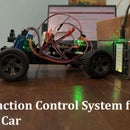Introduction: Making Various Paper Shapes Automotive Vehicle and Measuring Drag of It
There are a huge variety of shapes we see on road. various types of cars, trucks, bikes and also other 3 wheelers. All of them undergoes aerodynamic forces. Faster they go higher value of aerodynamic force it needs to overcome. For a slower vehicle, it is not a big concern. but performance vehicle it can become a limiting factor of maximum speed. Power consume to overcome the aerodynamic force are proportional to the velocity with the power of 3. So it is an important consideration for a high-speed vehicle. Even for medium speed vehicle better aerodynamics can enhance fuel economy.
In this instructable, I am going to explain how some basic (really basic!!!) type of aerodynamic test can be carried out. so that I can somehow compare aerodynamics of these vehicles with some numbers.
This project is just to have the understanding of drag forces on various objects not to measure accurate drag value.
Video for the similar project:
Step 1: Overall Approach of It:
To measure aerodynamic drag, I made a 3 wheeler car. On which I can attach various shapes and measure drag. This car is powered by a geared coreless motor. This is the similar kind of motor being used in most of the flying RC toys. This car does not has the inbuilt battery but need to be powered by the external source. As variation in battery voltage can yield the error in measurement.
This car moves in a circular fashion. a stick is connected to it from the center of the circle. At the center, a slider mechanism is made to transfer power from supply to rotating arm. There are two sliders required of which rotating element is made of Al foil and static part is made of copper wire.
In above image, various shapes of car and truck are shown that I made using A4 size paper sheets. For all trucks frontal area is same.
Making all these shapes using paper is an easy task. Firstly decide what vehicle you want to copy. take various photos of it. photo with exactly side view can be extra useful. Ignore complex curves try to make it as simple as you can make. Than take a scale of it that suits the size of the car. and perform the measurement.
Step 2: Doing Measurement for Drag for Trucks
I attached shapes of All 3 trucks one by one and apply the similar value of power to it. To measure velocity I measured the time required to complete 5 full circles and as the radius of circular path is known the speed of the car can be measured from this data.
I carried out the experiment on four shapes:
- Bus (just cuboidal),
- Truck without container,
- Truck with container,
- A truck with container and cabin fairing.
As can be shown in photos of result a cuboidal shape has very bad aerodynamics while a truck with cabin fairing is relatively good.
Step 3: Measurement for Various Car Shapes:
Now I attached various car shapes similar way to the truck. Unlike previous case this time length of the cars is similar. I took some reference photos of car form internet and made just simplified and scale down such that it can be made using paper.
All procedures for the experiment is similar to the truck. here I tested 3 types of the car:
- box type car,
- Hatchback car,
- Sedan car.
Step 4: Results and Conclusion:
Major conclusion for trucks:
- A cuboidal shape has bad aerodynamics than other shapes,
- Cabin fairing improves aerodynamics significantly. In this case improvement of 0.2m/s was obtained. This is a really big improvement for such a small and simple improvement. So a Truck with cabin fairing would give better fuel efficiency that without fairing for similar velocity.
Major conclusion for cars:
- A box type car has relatively bad aerodynamics, but it has maximum volume for the similar length which is necessary for the passenger or goods caring.
- Sedan car has the best aerodynamics but least volume for the similar length.
Hatchback car is somewhere in between having balance of performance and load caring.

Participated in the
Paper Contest 2018













